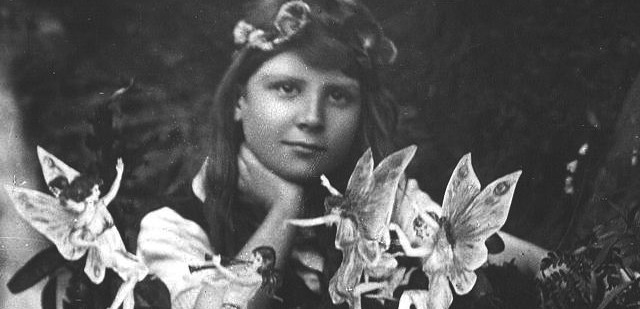
In a 1918 letter from Frances Griffiths to her friend, Johanna Parvin, living in South Africa, she said this:
Dear Joe,
I hope you are quite well. I wrote a letter before, only I lost it or it got mislaid. Do you play with Elsie and Nora Biddles? I am learning French, Geometry, Cookery and Algebra at school now. Dad came home from France the other week after being there ten months, and we all think the war will be over in a few days. We are going to get our flags to hang upstairs in our bedroom. I am sending two photos, both of me, one of me in a bathing costume in our back yard, Uncle Arthur took that, while the other is me with some fairies up the beck, Elsie took that one. Rosebud is as fat as ever and I have made her some new clothes. How are Teddy and dolly?
Hey, cute, just two friends pen-palling it up- wait, hold on a second, did she just say something about fairies?
Rewind a bit to one warm West Yorkshire Saturday afternoon in July 1917, Frances and her cousin, Elsie Wright, took Elsie’s father’s camera into the woods where they snapped off a few frames. Later, when Mr. Wright went about developing the photo plates, he was shocked to discover the forms of fairies traipsing across the images.
Later that same year in September, another fantastical photo came about: one consisting of Elsie sitting comfortably with a small winged-gnome dancing at her feet.
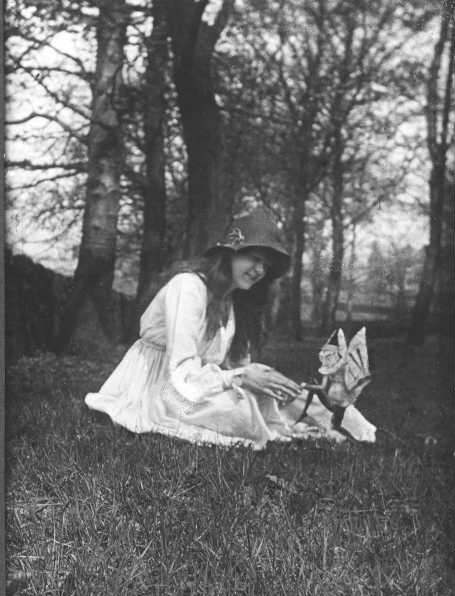
Elsie and the Gnome, 1917.
This time, however, Mr. Wright was seemingly more privy to their antics, and afterward decided not to let them use the camera anymore. He and his wife even went on to search the girls’ bedroom for proof that they’d falsified the photos with fairy cut-outs, only to turn up empty handed. All throughout, Elsie and Frances stuck to their story of seeing fairies, even stating that being amongst them was a pretty normal occurrence near the beck (a fancy term for stream) by their home.
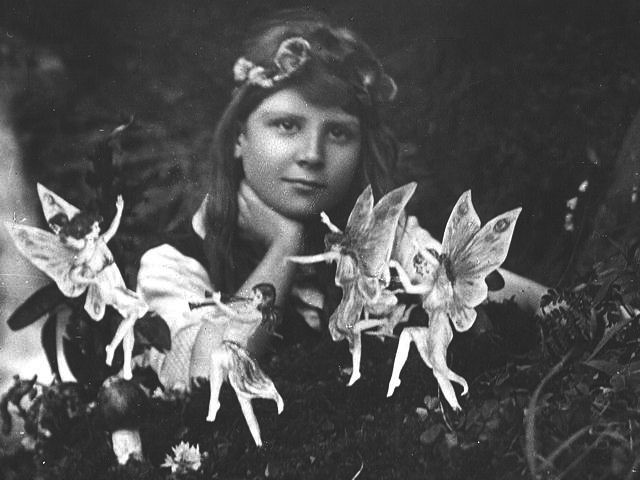
Frances and the Fairies, 1917.
In fact, on the back of the photograph Frances included with the letter to her friend in South Africa, she wrote:
Elsie and I are very friendly with the beck Fairies. It is funny I never used to see them in Africa. It must be too hot for them there.
Following the internal family-drama surrounding these supposedly faked photographs, a man named Edward Gardner was made aware of the photos, after they were included in a photo-gallery exhibtion on the subject of fairies in 1919.
All of this because Elsie’s mother had attended a meeting of the Theosophical Society, where she made known the existence of the pictures. Theosophists have one basic belief and goal, that being: bringing together members of any religion, creed, background, what have you, in search of witnessable truth. That truth could be god, science, ghosts, fairies, anything.
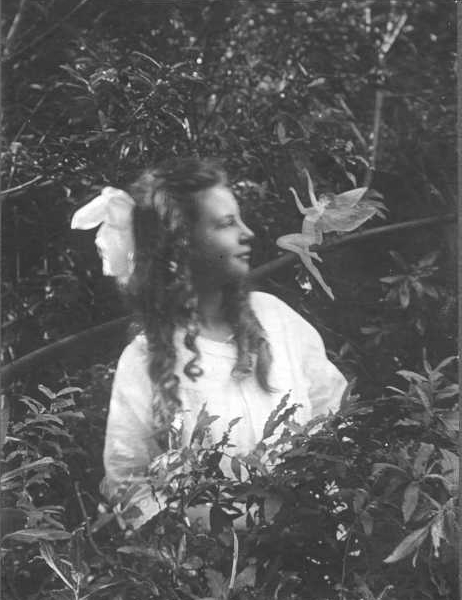
Frances and the Leaping Fairy, 1920.
And so, for a Theosophist like Gardner to suddenly be exposed to these photographs of “real proof of fairies”, can you imagine his excitement?
Of course, he was skeptical as well, even going so far as to have the prints and negatives examined by an expert, Harold Snelling. Snelling went on the conclude that the prints nor the negatives had been tampered with at least in post production, though he couldn’t state for sure that they were actually real fairies being shown in the pictures.
In comes the father of Sherlock Holmes himself, Arthur Conan Doyle, who I mentioned in my previous story about the History of Spirit Photography (a quick recap– he was a spiritualist!)
Just like Gardner, Doyle was totally over the moon about these photos, praising them to be 100% real, that certainly they were undeniable proof of fairies, that these two girls were basically gifts to the world (I might’ve exaggerated that a bit). It didn’t hurt that at the time he’d been tasked with writing for a magazine on the existence of fairies before ever even seeing the photos, but, you know, whatever. Details, details.
He and Gardner did, however, seek more insight from another professional, this time a from a few experts over at Kodak. All they could do was agree with Snelling’s original deduction, however, stating that it was clear the negatives themselves hadn’t actually been tampered with, but they could neither admit nor deny the actual authenticity of the fairies’ existence, and went on to refuse providing a certificate of authenticity.
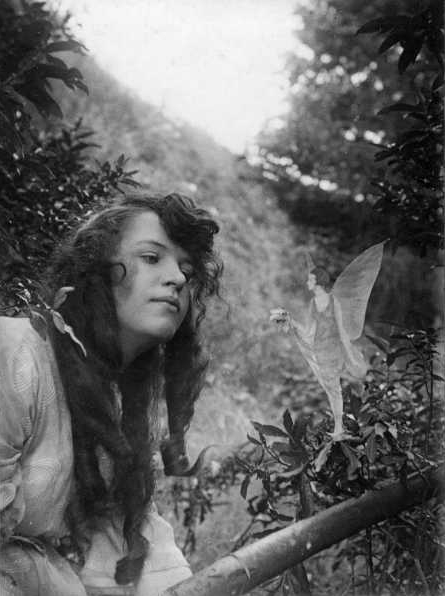
Fairy Offering a Posy to Elsie, 1920.
Either way, with the publication of Doyle’s article with the girls’ fairy photographs in tow, they soon became an absolute phenomenon. The magazine in which the article was printed sold out within two days.
Of course, not everyone believed the photos to be real, and there seemed to be a clean 50/50 split between those who were hesitant believers, and those who understood the photos to be nothing more than straight up fraud.
The girls’ fame continued to climb, however, though they soon grew tired of all the attention. When a practiced clairvoyant named Geoffrey Hodson came to visit their home, they took him out on a sort of “fairy walk” around the beck. Apparently, the girls mentioned seeing no fairies during his visit, but he himself claimed to see them them everywhere, even taking copious amounts of notes. Frances and Elsie went on to state that they both thought he was a fake, and only played along with him “out of mischief.”
It wasn’t until 1983 that the girls finally admitted the photos had been faked, the fairies in the images having been posed using art from a book and propped up with hair pins. They both maintained that they’d always been able to see real fairies, though, despite those in the photos being falsified.
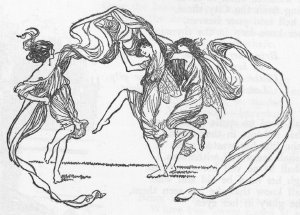
A page from Claude Arthur Shepperson’s book, Princess Mary’s Gift Book, 1914.

There exists only one photo from their fairy jaunts that both girls have differing opinions on in terms of legitimacy, Elsie affirming that it is a fake as all the others, whereas Frances insists that it’s genuine. Experts, however, have come to a pretty clear consensus that it’s simply a mistaken double-exposure of fairies in the grass, giving them a more translucent, ethereal feel, in comparison to the others.
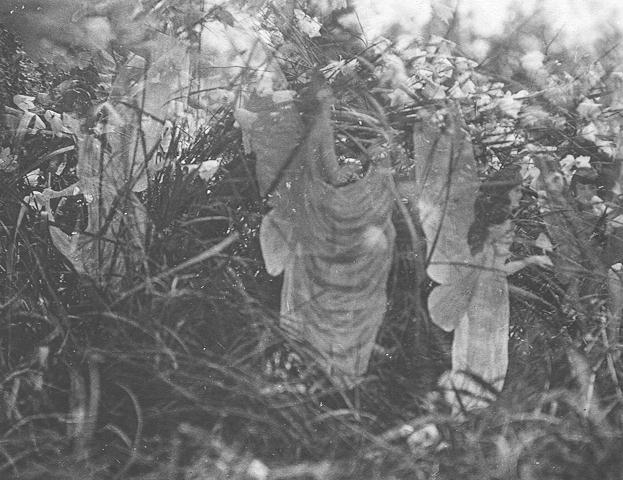
Fairies and Their Sun-Bath, 1920.
In Frances’ memoirs, Reflections on the Cottingley Fairies, Frances writes:
I hated those photographs from the age of 16 when Mr Gardner presented me with a bunch of flowers and wanted me to sit on the platform [at a Theosophical Society meeting] with him. I realised what I was in for if I did not keep myself hidden.
I think it’s so intriguing that such photos which we, now in 2017, can clearly see are fake cardboard cutouts, could have ever been perceived as “maybe, possibly, real.” But with photography still in its infancy, the general populace had never seen anything like it– kind of like when we were first being exposed to CGI in movies, we would think, “Whoa! This is so real!” but now, watching a CGI movie from 2010 in 2017, we cringe at the sight.
Can you think of any other photographs, videos, or other supposedly paranormal phenomenon that was once widely perceived to be real, only to be later proven (or confessed) to be faked? For me, the first one I think of off the top of my head is that infamous bigfoot tape, AKA the Patterson Footage. Although technically, I don’t think that’s been proven fake. Bigfoot is real. Don’t fight me on this.
If you want a quick recap of the Cottingley Fairy Adventures, here’s a gem from my favorite tv show in the whole world, Drunk History. (Caution: language):
Want to read some more? Check out these sites!
The Cottingley Fairies
The Case of the Cottingley Fairies
Kelsey graduated from Boise State University with a BA in Visual Arts, and is currently working as a freelance writer, while doodling anime on the side with one hand and petting cats with the other.

Another awesome article, Kelsey! This has always been one of my favorite stories. Never thought to write about it here. I’m glad I didn’t though. You covered it brilliantly. Thank you!